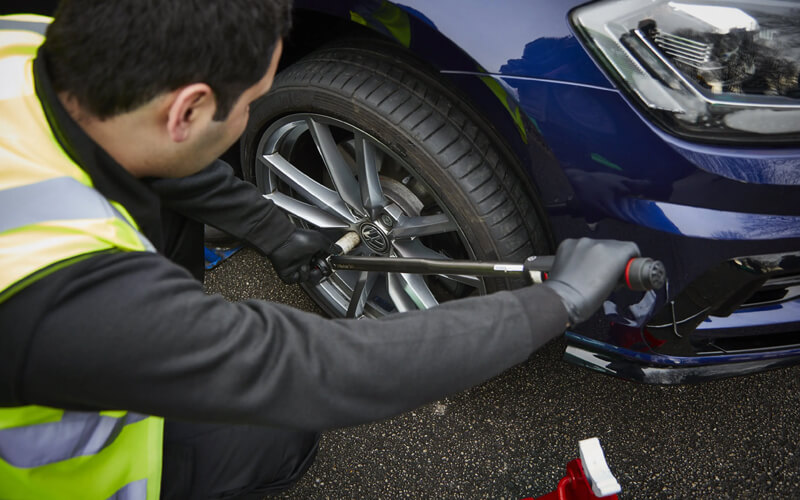Search Tyres by Vehicle Registration
Are you looking for Tyres Fitting for your vehicle?

Tyre fitting - what is being done?
During tyre assembly, the old tyres are first removed from the rim. Then the new tyres are put on the rim. Finally, the assembled tyres are precisely balanced with the latest technology.
On request, you can have your tyres discarded by the workshop.
If you need a change of tyre in addition to tyre mounting, you can book this service additionally.
Tyre assembly and wheel change: What are the differences?
Tyre mounting includes removing the old tyres from the rims and putting the new tyres on the rims. The assembly of the complete wheels on the vehicle is not part of the tyre assembly.
A set of wheels (e.g., rims with summer tyres) is unscrewed from the vehicle during the wheel change. Then we screw another set of wheels (for example, rims with winter tires) on the vehicle. If you bought new tyres, the new tyres will not be part of the wheel changes.
When do you need new tyres?
Age, as well as profile depth, are considered as indicators for the exchange of tires. Although there is no statutory maximum age for vehicle tyres, our Mill Tyres experts recommend replacing them after five years. This is due to the curing of the rubber mixture and the possible occurrence of porous sites. The DOT number, a four-digit number on the tyre edge, provides information on the age of the tyre. While the first two figures correspond to the production week, the last two figures indicate the year of production.
The actual tyre assembly carried out in our workshop using a special tyre-mounting machine. The rim is first tensioned on the machine. Special care is to be taken when handling aluminium rims. Therefore, plastic clamping claws are usually used. After the beads of the tyre to be assembled have been treated with lubricant, the tyre beads are carefully applied to the rim. The internal and external sides, as well as the direction of rotation of the tyre, must be observed. If the tyre rests on the rim, it can be filled with air. After this, it can be balanced and mounted on the vehicle.
When changing the wheel, the vehicle is driven onto the lifting platform, and all wheel bolts are loosened. This is best done with a cross-wrench or a wrench. The wheel bolts are placed aside so that they are ready to hand when mounting the new wheels. If rust is present on the wheel hub, it is advisable to remove it with abrasive paper. The new wheels can then be placed on the wheel hub. A centring ring or bolt can be helpful to put the wheel exactly on the wheel hub so that it can be screwed back quickly. After the wheel bolts have been set, these are tightened cross-wise using a cross-wrench or torque wrench. Alternatively, a propeller can also be used for this purpose. After releasing the vehicle from the lifting platform, the air pressure in the tyre is checked, and the vehicle is ready for the new season. After 60 miles of driving, the wheel bolts should be re-tightened.
This shows that you need new tyres
Age, as well as profile depth, are considered as indicators for the exchange of tyres. This is due to the curing of the rubber mixture and the possible occurrence of porous sites. The DOT number, a four-digit number on the tyre edge, provides information on the age of the tyre. While the first two figures correspond to the production week, the last two figures indicate the year of production. A distinction is made between summer and winter tyres in the profile depth of the tyres. It is true that both summer and winter tires must have a minimum profile depth of 1.6 mm, but the AA and many other organisations provide different guide values. According to this, summer tyres with 2.5mm profile depth and winter tyres with a rest profile of 4mm should be replaced. The less profile depth is available, the worse the driving characteristics in snow and rain. Thus, for example, there is increased aquaplaning tendency of the vehicle. Tyres with a low profile depth, therefore, represent a considerable safety risk.
This is how to find the right tyre
The most suitable tyre sizes for the respective vehicle are taken from the vehicle papers. All released tyre dimensions are entered there. A common tyre dimension would be, for example, 205/55 R16 91V. The number 205 indicates the tyre width in millimetres. The number 55 denotes the ratio of the flank height to the tyre width in percent. The letter R says it is a radial tyre. 16 indicates the diameter of the appropriate rim in inches. The number 91 is the load capacity index of 615 kilograms. The letter V indicates the maximum permissible speed of 240 km/h. If a wheel dimension other than that which has been released by the vehicle manufacturer is to be mounted on its vehicle, it must be determined by an expert whether this is technically safe. It must also be entered in the vehicle documents. Otherwise, the operating permit will be extinguished.
We at Mill Tyres in Boston will always be happy to advise you on which tyres are most suitable for your vehicle (and your budget). Just get in touch.
